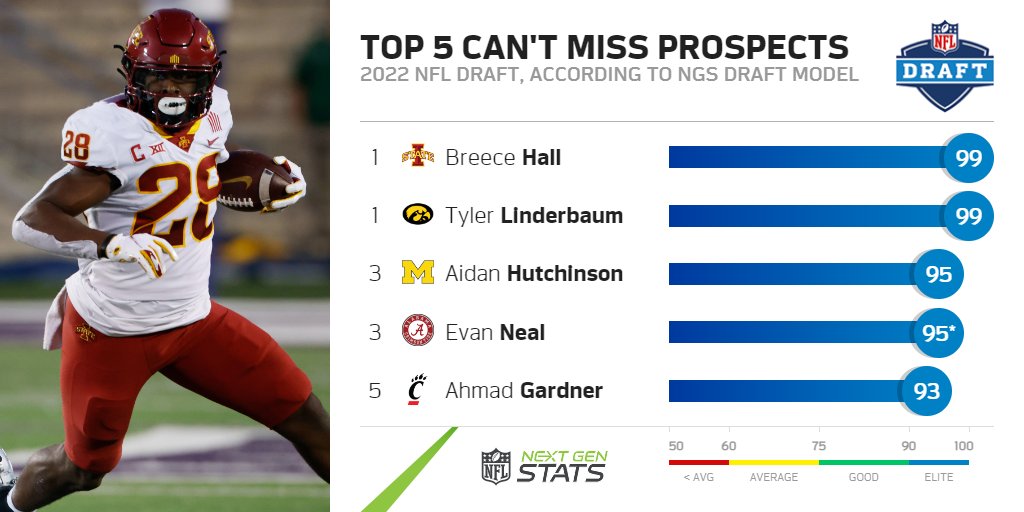NFL NEXT GEN STATS, POWERED BY AWS
Draft Score Q&A
Q&A with the NFL's Next Gen Stats about Draft Score, a prospect evaluation tool powered by AWS, to better understand the technology and science it takes to make the grade.
With shocking trades, big signings, and the 2022 Draft just days away, this NFL offseason has been one for the history books. As the draft's first selection approaches, we sat down to talk X's and O's with the NFL's Next Gen Stats about Draft Score, a prospect evaluation tool powered by AWS, to better understand the technology and science it takes to make the grade.

We have models separated by position: Quarterback, Running Back, Receiver, Tight End, Tackle, Interior Offensive Line, Edge, Defensive Tackle, Linebacker, Cornerback, Safety. Every position has different size, athletic, and production-based features that are more important than others.
We assign each player a Production Score, which is how productive you were at the college level, and an Athleticism Score, an athletic performance metric. And then, we merge everything into our other models to create an overall score.
The college data we can access for the model is limited to what’s publicly available. The teams have much more robust data collected by scouts, so this year we’ve expanded our Production Score to include a scout grade from our own Daniel Jeremiah and Lance Zierlein. The way we’ve structured the models allows us to add in more components to achieve a better predictive outcome in the future.
We have a small data set. Just over six thousand lines of data. That’s how many players that have been invited to the Combine since 2003. We have a model for every single year of the Combine. And that group of models is under an umbrella, like the Athleticism model. And then we separate that out by each position. We’ve found the ensembling of a series of models to exemplify certain dimensions of players got us to the point where we have more than 3,000 models for these 6,000 rows.
The modeling process works like this: We model every draft class (since 2003) against history, leaving a single draft class out. In other words, a prospect’s score is generated from a model that did not including the player in the training set. Hence the need for so many models. This was big for reducing overfitting when back-testing the model results.
So, the 2022 class has 19 historical models to build from. Ultimately for this year’s class, we have the 11 positions times five outcome models times 20 historical models for a total of 1,200 models to output one Athleticism Score alone.
For each dimension (athleticism, production, and overall), and class (between 2003 and 2022), we’re looking at a number of variables: the probability of starting as a rookie; the probability of starting your second year; the probability of starting your third year; the probability of starting in your first three years at all; and the probability of making the Pro Bowl in your first three seasons.
And how did we pull it off? Our engineering team is comprised mostly of software engineers, so we didn’t come into this with prior knowledge of how to set up a Machine Learning workflow of such complexity. Our interaction with Amazon’s ProServe team helped us do our work correctly and efficiently. Interacting with these data scientists helped us expedite our process, so we could focus more time on analyzing data instead of organizing it.

Pretty good! This is the third year we have released our list of seven “can’t-miss” prospects. Looking back, our top 14 prospects from the past two years have included all four AP Rookies of the Year — Ja’Marr Chase and Micah Parsons in 2021, and Justin Herbert and Chase Young in 2020.
Here is an in-depth article we wrote that looks at our are the top seven can’t miss prospects seven for the 2022 NFL Draft. These “blue chip” prospects each have a Draft Score of at least 91 and project to be top-50 picks.
Using Postgres made it easy for us to start up, because it was already within our AWS ecosystem. Migrating the data over was pretty easy. And we can connect our RDS to QuickSight. Not only do our partners have QuickSight internally, but every club has it, so we get calls saying, “Hey, can you tell us more about the Draft Score?”
Managing the versioning and data sets of thousands of different things all at once gets really complicated. We leverage s3 to do all the version management for us. The actual use case is a simple call through the SDK. We just need to store a lot of iterations of data and iterations of the models. We need to save everything every time we rerun something, and we attach a unique timestamp to it so that under those buckets are unique folders. S3 has made our iterations much quicker, and we don’t lose track of our model.
Right now, we track countable player data, but we don’t get any data from tracking player movement with computer video analysis. What if a player ran a 40 at 4.55, 4.59, and 4.65? You can imagine a player doesn’t run in a straight line over 40 yards. They could be running diagonally. They might actually have run 41.5 yards in a dash. What if we could analyze player movements in space in the 40 and other drills to determine a level of “true speed?” We could go from seven or eight metrics that we get from Combine data to an ocean of engineered metrics.
